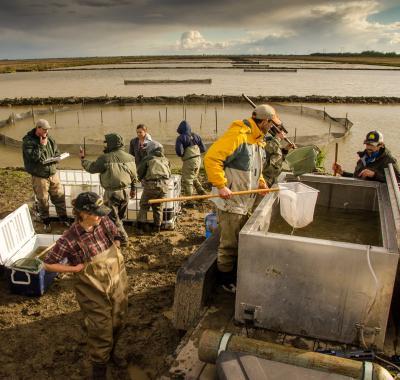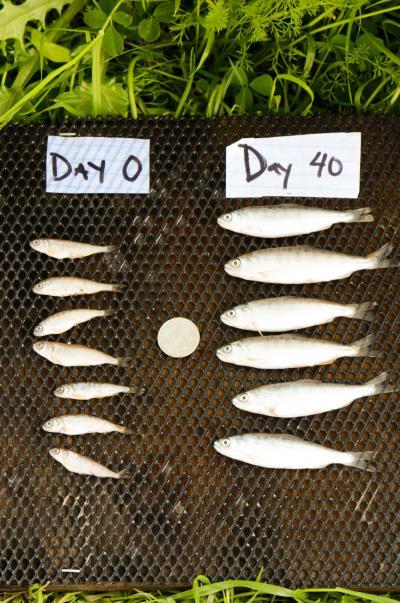From a fish-eye view, rice fields in California's Yolo Bypass providean all-you-can-eat bug buffet for juvenile salmon seeking nourishmenton their journey to the sea. That's according to a new reportdetailing the scientific findings of an experiment that planted fishin harvested rice fields earlier this year, resulting in the fattest,fastest-growing salmon on record in the state's rivers.
The report, provided to the U.S. Bureau of Reclamation, describesthree concurrent studies from researchers at the University ofCalifornia, Davis, nonprofit California Trout and the CaliforniaDepartment of Water Resources. The scientists investigated whetherrice fields on the floodplain of Yolo Bypass could be managed to helprecover California's populations of Chinook salmon, and if so, theideal habitats and management approaches that could allow both fishand farms to thrive.
"We're finding that land managers and regulatory agencies can usethese agricultural fields to mimic natural processes," said co-authorCarson Jeffres, field and laboratory director of the Center forWatershed Sciences at UC Davis. "We still have some things to learn,but this report is a big step in understanding that."
Researchers found that the fish did not have a preference among thethree rice field types tested: stubble, plowed and fallow. The foodsupply was so plentiful that salmon had high growth rates acrosshabitats and management methods.
"It's like a dehydrated food web," said Jeffres of the harvested ricefields. "Just add water. All of those habitats are very productivefor fish."
The salmon did demonstrate a preference for habitats with betterwater flow. Jeffres compared it to choosing among three goodrestaurants: Each offers good food with hearty portions, but one hasbetter ambience and so is chosen above the others. In this case, thebetter water flow was the ambience the fish preferred.
Among the key findings:
- Experimental flooding of Yolo Bypass rice fields during the wintercan create productive aquatic food webs for salmon.
- Average growth rates during the study's 41 days were the highestrecorded in freshwater in California. Growth of juvenile Chinookaveraged 0.93mm per day, with growth of 1.5 mm per day observedduring specific two-week intervals.
- Mortality was greater than in the team's previous 2012 study atKnaggs Ranch. In the 2013 study, between 0 and 29 percent offree-swimming fish survived, while 35-98 percent of fish inenclosures survived.
- Lower survival rates were attributed to bird predation. The winterof 2013, when the study was conducted, was one of the driest onrecord in the Sacramento Valley, which may have drawn more birds tothe inundated rice fields, and to the fish. The study plots were alsorelatively shallow, providing little escape for fish. A follow-upstudy planned for 2014 will explore the role of depth as a refuge forfish against avian predators.
- Fish reared in plowed rice fields grew faster than those rearedover stubble or weedy vegetation. However, all habitat types werebeneficial to the fish, suggesting farm managers may have moreflexibility in land treatment after harvest.

UC Davis Center for Watershed Sciences and California Trout researchers study salmon growth in seasonally flooded rice fields in the Yolo Bypass near Woodland, Calif., on Feb. 19, 2013. Scientists are investigating whether the Central Valley's historical floodplains could be managed to help recover California's populations of Chinook salmon.
(Photo Credit: Carson Jeffres/UC Davis)
"These results are good news for the effort to rebuild salmonpopulations in California," said lead author Jacob Katz, a biologistwith California Trout. "We've always suspected that when we mimicnatural flood processes in agricultural fields, we give these fish afood-rich habitat they recognize and thrive in. These findingssupport that theory and provide a strong path forward for Californialand use planners, conservationists and farmers alike. This is awin-win model that can be replicated around the state."
The Yolo Bypass is the Central Valley's largest contiguous floodplainand provides critical fish and wildlife habitat, the report said. Itis covered by floodway easement held by the state of California,making other land uses subservient to flood control. Agriculture is amajor land use in the bypass, with rice the primary crop.
More than 95 percent of Central Valley floodplain habitat that washistorically used to rear juvenile Chinook salmon has been altered,primarily diked, and drained for agriculture conversion. Most formerfloodplain wetlands are now only inundated during major floods. Thereport said access to floodplain habitats and the high growth ratesassociated with them during even a limited time may be critical inimproving return rates for Central Valley salmon populations.

In winter 2013, a UC Davis-affiliated experiment in rearing salmon on the farmed Yolo Bypass floodway near Sacramento produced remarkable results. In 40 days, juvenile Chinook salmon grew nearly 1.5 inches longer and packed on weight at an average rate of 0.17 grams a day (pictured). Juvenile salmon that started at the same size and were released into the Sacramento River at the same time grew only about half as fast (not pictured).
(Photo Credit: Carson Jeffres/UC Davis)
Source: University of California - Davis